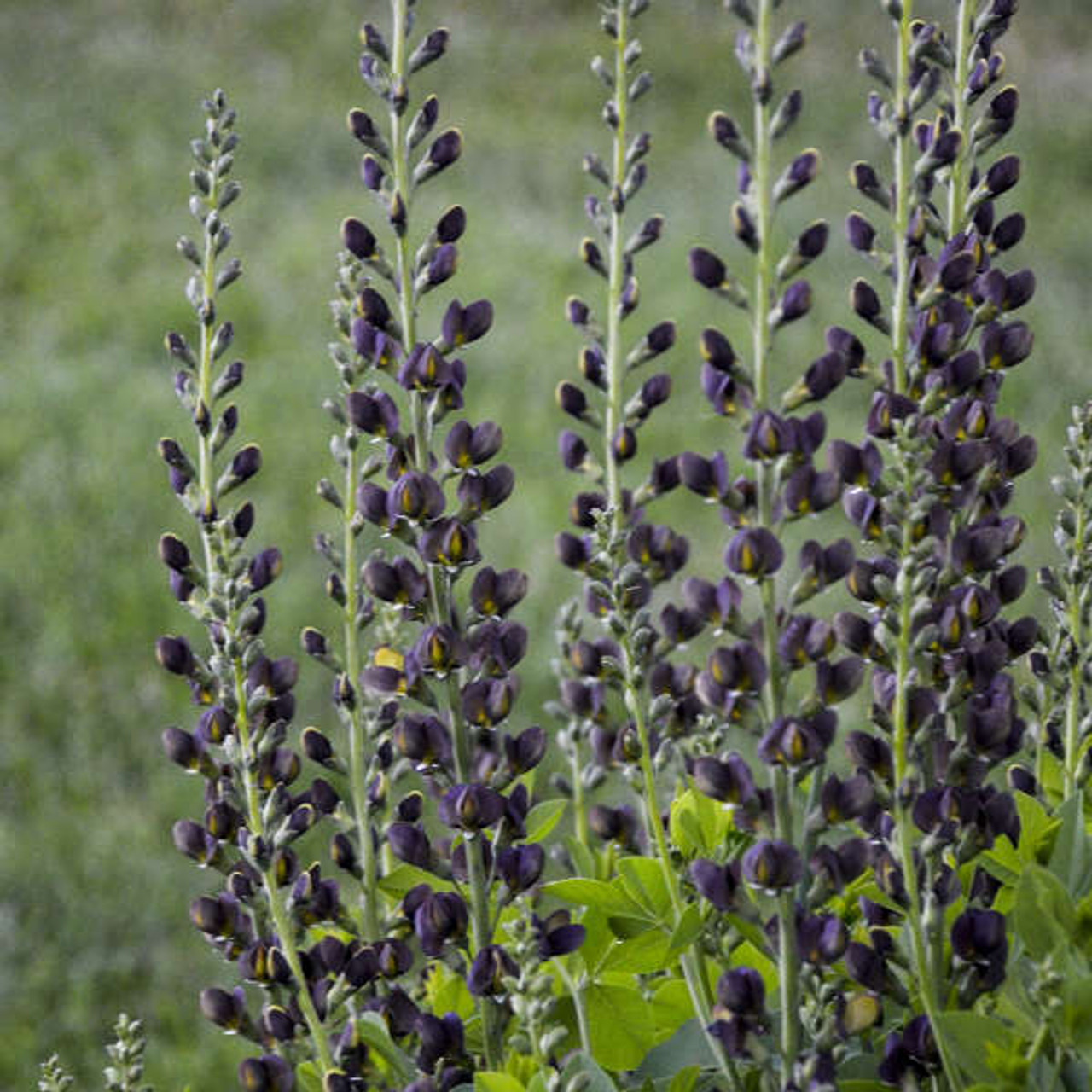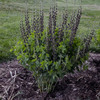Product Description
Baptisia 'Dark Chocolate' PP30959 CPBRAF (25) Bare Root Plants
DECADENCE® Series
Common Name: False Indigo
Did you love the deep flowers of 'Dutch Chocolate'? Meet the new and improved version, 'Dark Chocolate'. This variety shares that same, nearly black, charcoal purple flowers, but has much longer flower spikes-up to 27" long. The flowers grow well out of the foliage, an improvement on its predecessor. Forms an incredibly full and bushy habit-a perfect substitution for shrubs if you're looking for structure in the garden.
Baptisia is easy to grow and will thrive with little maintenance. There are many potential applications in the landscape including meadow plantings, as a backdrop in borders, or as a specimen. Plants are very long-lived once established.
The roots of the DECADENCE® series run deep. What started as a fun botanizing trip in the lower Midwest with a fellow horticulturist blossomed into a complex hybridizing project for breeder Hans Hansen. Hans has made countless crosses with the many native Baptisia species he has collected across Texas and Oklahoma. These crosses have resulted in an array of seedlings with unique flower colors and plant habits. Only the very best have made it into the new DECADENCE® Series, which includes varieties selected for their desirable flower colors and shorter, more compact habit.
Baptisia grows best in full sun, though it tolerates light shade. If grown in too much shade, plants may require staking. Baptisia is easily grown in poor to average soil that is well-drained. Once established, it is moderately drought tolerant because of its tough, deep taproot. This perennial native may take a couple of seasons to become established but is very long-lived once mature. Avoid disturbing established clumps.
Height: 3.0-3.5 Feet
Spread: 3.0 Feet
Hardiness Zones: 4,5,6,7,8,9
Flower Color: Purple shades, Near-black shades
Foliage Color: Green shades
Full Sun (> 6 hrs. Direct Sun) - Part Shade (4-6 hrs. Direct Sun)
Low to Average Water Needs
Poor to Average Soil Quality
Bloomtime: Late Spring - Early Summer
Attracts Butterflies
Bee Friendly
Deer Resistant
Growth Rate: Medium
Border Plant, Cut Flower, Drought Tolerant, Easy To Grow, Salt Tolerant
Baptisia 'Dark Chocolate' is a stunning perennial plant that belongs to the Decadence Series. It is an excellent choice for gardeners looking to add a touch of drama to their landscapes. With its dramatic, near-black blooms and blue-green foliage, this plant creates an unforgettable focal point in any garden. The characteristics, care requirements, growth habits, and more of Baptisia 'Dark Chocolate'.
Characteristics Baptisia 'Dark Chocolate' is a hybrid variety of false indigo that is known for its unique flower color. Did you love the deep flowers of 'Dutch Chocolate'? Meet the new and improved version, 'Dark Chocolate'! This variety shares the same, nearly black, charcoal purple flowers, but has much longer flower spikes — up to 27" long. The flowers grow well out of the foliage, an improvement on its predecessor. The flowers bloom in late spring to early summer. The flower spikes can reach up to 27 inches long, making them perfect for flower arrangements. The foliage is a beautiful blue-green color and forms a bushy, spreading mound that remains neat all season long. In the fall, the plant forms interesting seedpods that turn charcoal-black and persist into winter.
This plant is a relatively compact variety of Baptisia, typically growing to be about 30-36 inches tall and 36 inches wide. It is a long-lived perennial that is hardy in zones 4-9. Baptisia 'Dark Chocolate' is also drought tolerant and salt tolerant. It is a host plant for several butterfly and moth species, including the Wild Indigo Duskywing, Eastern Tailed-Blue, Clouded Sulphur, and Orange Sulphur.
History of Baptisia 'Dark Chocolate' What started as a fun botanizing trip in the lower Midwest with a fellow horticulturist blossomed into a complex hybridizing project for breeder Hans Hansen. He collected seeds from various Baptisia species and began crossing them to create new and improved varieties. Only the very best have made it into the Decadence Series, which includes varieties selected for their desirable flower colors and shorter, more compact habit. 'Dutch Chocolate' is in the Decadence® series and was bred in 2003 by Hans Andrew Hansen of Walters Gardens, Inc. in Zeeland, Michigan. Decadence® false indigos were bred for desirable flower colors, a shorter, more compact habit, and to be hardy in Zones 4 to 9. 'Dutch Chocolate' is the result of a cross made in 2003 between an unnamed selection of Baptisia minor as the seed parent and an unnamed plant of Baptisia sphaerocarpa as the pollen parent.
Care Requirements Baptisia 'Dark Chocolate' is a genuinely carefree perennial. It is a low-maintenance plant that thrives with little maintenance. It prefers full sun but can tolerate some shade. It grows best in average, dry to medium, well-drained soil. Once established, it is quite drought tolerant.
Watering Water regularly during the first growing season to help the plant establish a deep root system. Once established, it is drought tolerant and only needs to be watered during periods of extended dryness.
Fertilizing Baptisia 'Dark Chocolate' does not require fertilization.
Pruning Deadheading is not necessary. However, you can trim the foliage after it blooms to maintain a rounded plant appearance. If you do this, you will miss out on the attractive seed pods.
Winter Care No special winter care is needed.
Growth Habits Baptisia 'Dark Chocolate' is a clump-forming perennial that spreads by underground rhizomes. It has an upright growth habit and forms a bushy, spreading mound. It may take a couple of seasons to become established, but it is very long-lived once mature.
Companion Plants Baptisia 'Dark Chocolate' pairs well with a variety of other plants. Here are a few suggestions for companion plants:
- Amsonia 'Storm Cloud'
- Dianthus 'Paint the Town Magenta'
- Euphorbia 'Ascot Rainbow'
- Geranium 'Rozanne'
- Panicum 'Apache Rose'
- Polemonium 'Heaven Scent'
Potential Problems While Baptisia 'Dark Chocolate' is generally a low-maintenance and problem-free plant, there are a few potential issues to be aware of. Keep an eye out for aphids, thrips, and spider mites. Crown and root rots may occur without proper drainage. Baptisia can be sensitive to juglone and may perform poorly when planted near black walnut trees.
Uses in the Landscape Baptisia 'Dark Chocolate' is a versatile plant that can be used in a variety of ways in the landscape. It looks stunning in beds and borders, cottage gardens, prairies or meadows, and native plant gardens. It is great as a specimen plant or in small groups. It can also be used as a backdrop in borders or as a specimen.
Baptisia 'Dark Chocolate' is a beautiful and unique perennial plant that is a valuable addition to any garden. Its dramatic, near-black flowers add a touch of elegance and sophistication to any landscape. As a low-maintenance, drought-tolerant, and long-lived plant, it is an excellent choice for gardeners of all skill levels. It is also a valuable plant for pollinators, attracting butterflies and bees to the garden. With its stunning flowers, attractive foliage, and carefree nature, Baptisia 'Dark Chocolate' is sure to be a favorite for years to come.
Other Details
The most important part of the plant is its root system. Healthy roots are the foundation of a healthy, vibrant plant. The type of plug container used is based on the specific needs of the plants. Perennials offered as bare root traditionally perform better when planted as bare root.Planted in a specialized mix, potted plants have well established root systems. Top growth stage will vary depending on the current life cycle and time of year when shipped. In Winter and early Spring dormant plants may be shipped. Dormant plants may be planted right away, even before the last frost date.
Most bare root varieties are field grown for at least one season, though Hemerocallis and Hosta are grown for two seasons. The bulk of the soil is removed during the harvesting process and the tops of most varieties are trimmed back to the crown. They are graded, packed in shredded aspen or sphagnum moss and stored in freezers until ready to be shipped.
See our Container Sizes and Bare Root Perennials pages for more information.
Plant information and care is provided in the Overview section, Plant Genus Page and general information is provided in the Planting Care & Guides. Additional questions can be asked on each Plant page.
Plant Spacing: Using the maximum mature spread or width of a plant to guide spacing, ensures space to grow to full size. To fill an area sooner, plant them closer together. Just remember, future thinning or transplanting may be needed.
Water: Keep a close eye on newly planted perennials, especially throughout the first growing year. Most early plant loss is due to too much or too little water!


















